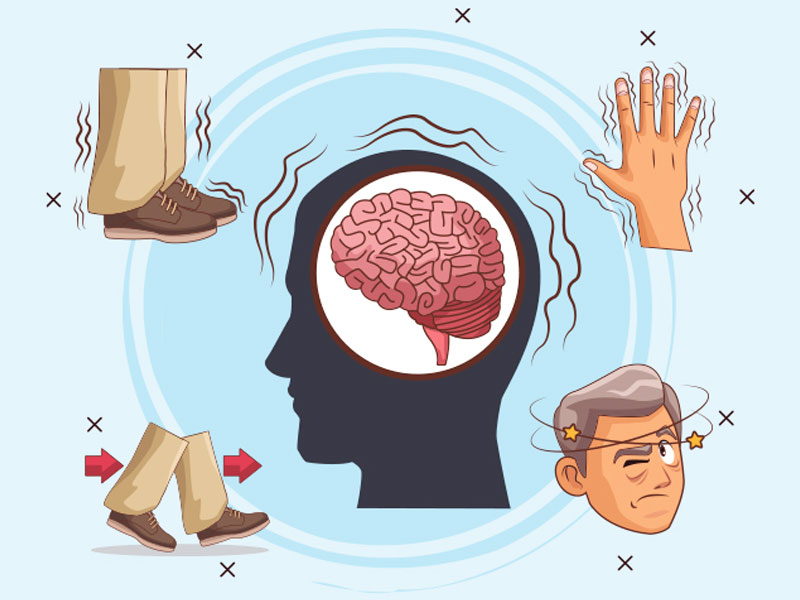
Parkinson’s disease is the second most common progressive neurodegenerative disease after Alzheimer’s disease. It is a progressive disease commonly seen in the elderly population. It occurs as a result of progressive loss of dopamine secreting cells in the substantia nigra. Dopamine is an essential chemical that plays an important role in movement initiation and speed, keeping the body flexible and steady. Know about Parkinson’s risk factors, symptoms and treatment options by Dr Syed Moeed Zafer, Consultant Neurologist and Movement Disorders Specialist, Masina Hospital
Table of Content:-
Risk Factors
Parkinson’s disease is thought to result from a complex interaction between environment and genetic factors; about 15% of cases are due to genetic causes. There is a significant association between Parkinson’s and exposure to chemicals and pesticides-rural living, well water has been implicated, and welder’s and miners are at high risk. Caffeine intake, apples and flavonoids are found to be protective.

Also Read: Tips To Handle Parkinson's Disease Effectively
Symptoms of Parkinson’s disease
Parkinson’s disease commonly presents with tremor, slowness of body movements, stiffness in the extremities (predominantly affecting one side of the body) and gait disturbances(walking-related issues). Other motor (movement-related) symptoms include the expressionless face, low volume speech, change in handwriting and flexed posture. Apart from the motor symptoms mentioned above, there are various non-motor symptoms that commonly accompany the motor manifestations or can occur much early before the onset of motor symptoms. These include loss of smell, constipation, sleep issues like frequent awakening, enacting dreams in sleep and restless legs, depression and anxiety are usually seen early in the course of the disease. Non-motor symptoms commonly seen in late stages are memory disturbances, behavioural issues, visual hallucinations, compulsive eating, compulsive buying, hypersexual behaviour, gambling, pain and fatigue.

Treatment
Parkinson’s disease symptoms can very well be controlled with medicines even though its progression cannot be slowed down or stopped.
Oral therapies: The commonly used medicines for Parkinson’s disease either directly replenish the levodopa stores in the brain(Levodopa), substitute for it at the target sites(dopa agonists) or inhibit the breakdown of naturally available levodopa(MAO and COMT inhibitors). The symptoms can be very well controlled in the initial few years with these medicines, but as the disease progresses, there might be fluctuation in responsiveness to them known as the “ON-OFF” phenomenon in which the symptoms disappear after taking medicine and then re-appear once the drug levels decline.
- Device assisted therapies: In moderate to advanced stages of Parkinson’s disease, when the available oral therapy is not sufficient to control the motor or non-motor symptoms, device-assisted therapies are considered. These consists of Deep Brain Stimulation, Apomorphine infusion pumps and Levodopa infusion pumps.
- Deep Brain Stimulation is a continuous stimulation of deeper structures in the brain (circuits implicated in Parkinson’s disease) through implanted electrodes which are connected via wires to a battery placed over the chest wall beneath the skin-in simple language, it is a “brain pacemaker”.
- Apomorphine infusion pumps and pens deliver apomorphine subcutaneously for better absorption and quick action. Infusion pumps also ensure continuous delivery of the medicine, thereby reducing the fluctuations.
- Levodopa pumps (not available in India) deliver levodopa directly into the intestines through a surgically placed tube hence improving the absorption and ensuring continuous delivery.
Also Read: You Are At A Risk Of Getting Parkinson's If You Take Antibiotics Regularly
These device-assisted therapies are very effective and significantly improve the quality of life of Parkinson’s patients, although they do not have an effect on disease progression. Exercise in any form is good for Parkinson’s patients and is the only thing that has some evidence of slowing down the progression of Parkinson’s disease. Hopefully, with the ongoing research to find a curative treatment, in the near future, we expect a cure for Parkinson’s disease.
With inputs from Dr Syed Moeed Zafer, Consultant Neurologist and Movement Disorders Specialist, Masina Hospital
Read more articles on Other Diseases
Also watch this video
How we keep this article up to date:
We work with experts and keep a close eye on the latest in health and wellness. Whenever there is a new research or helpful information, we update our articles with accurate and useful advice.
Current Version